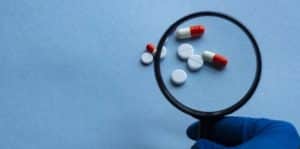Introduction and Initial Assessment
When anti-counterfeiting investigations result in criminal actions on the ground, they are often thought of as examples for successful enforcement. However, for IP owners with large portfolios, such actions may only constitute a drop in the ocean. This is particularly true for the pharmaceutical industry, where price points are high and the demand for medicines can often exceed the supply. This can create great temptations for nefarious parties looking to profit by introducing counterfeit products to the supply chain. When Authentix onboards a pharmaceutical client for online brand protection services, our team undertakes an extensive and sophisticated strategy to not only identify suspected counterfeiting threats but also to help formulate a series of strategies to counter and remediate them. Typically, our pharmaceutical clients engage with us to help uncover the following data:
- The scale of trademark infringement
- The key channels where counterfeit products are made available
- The key sources of illicit trade and concentrations of geographical risk
- The limitations of potential enforcement strategies for various jurisdictions and geographies
Once these trends and threats are clearly mapped out, Authentix will recommend key, proven strategies that are realistic and practicable with the acknowledgement that our clients have finite resources, that certain detected sources and channels of illicit activity must be prioritized over others, and that certain jurisdictions and platforms can be more resistant to traditional forms of enforcement and remediation for trademark and product counterfeiting possibly requiring alternative legal strategies.
Case Study: Mapping the Scale of the Problem
One Authentix client, a large, global pharmaceutical manufacturer, has a large IP portfolio spanning hundreds of brands, and was concerned over various reports of suspected fakes for one of its popular prescription products used for topical skin conditions. Authentix began working with the client by scanning dozens of online marketplaces, social media platforms and standalone websites for data, using proprietary software and a team of research analysts. The parameters for the initial scan ranged from categorizing suspicious seller details (such as low ratings and low prices) to visual signs showing suspected infringing trademark use. Authentix’s team of expert analysts classified activity on nine major platforms as high-risk, given the volumes of suspicious listings and the popularity of these platforms. Authentix proposed prioritizing enforcement actions against perceived high-risk sellers on these nine platforms.
Authentix flagged multiple categories of high-risk activity, especially the sale and advertising of suspected counterfeit products. Through the use of hidden links and blurred logos, several rogue sellers had managed to list these fakes on many marketplace platforms. Apart from counterfeits, Authentix also flagged activity such as the sale of the product in the absence of a legal prescription, the sale of active pharmaceutical ingredients (APIs), and unauthorized parallel imports.
Next, the team began digging deeper by using a combination of open-source investigations, trade database analyses, and stealthy social media chats with suspected rogue sellers. Authentix determined a cluster of traders in Pakistan to be a primary source of the suspected counterfeits within the ASEAN region, Turkey and India were identified as the key destination countries; and also concluded that China and Central Asia were key points of transit.

Executing the Right Strategies for Successful Outcome
Authentix prepared a strategy of filing complaints against high-risk listings using a combination of IP-related and public safety grounds. This was essential in certain cases, where platforms are somewhat resistant to recognizing grounds for IP infringement other than in classic counterfeiting contexts. Some of these complaints also required test purchases for support. Outside of takedown notices, certain rogue entities and third parties were targeted independently of the platform. Such targeting included civil actions or criminal enforcement, leveraging Authentix’s connections across the Asian region for on-the-ground raids, seizures, and other legal action in addition to removing infringing listings from online platforms and e-commerce sites around the world. For some clients, even on-ground enforcement requires a physical investigation to confirm the identity of the targets in question and gather actionable evidence.
Authentix has overseen numerous on-the-ground criminal enforcement actions against pharmaceutical counterfeiters (see here, for example). Many clients prefer to first be presented with a range of tailored options where they can target counterfeiters in the most efficient and cost-effective way. Authentix Online Brand Protection Group can help clients in this decision process by providing expert advice and customized solutions based on our proven level of experience, as well as legal options offered through an extensive network of IP lawyers across Asia.
Authentix Online Brand Protection currently supports over 300 brands and 6 million enforcement actions per year across many different forms of IP infringement. Customers appreciate how our streamlined onboarding process makes it easier to scale protection efforts in new markets, platforms, and product lines. It also allows for faster adaptation to emerging threats or changes in brand protection strategy. Authentix stands as a trusted leader, offering tailored solutions for the most effective online brand protection and peace of mind. Learn more about our online brand protection solutions by reading our eBook or schedule a consultation with one of our online protection experts today.
